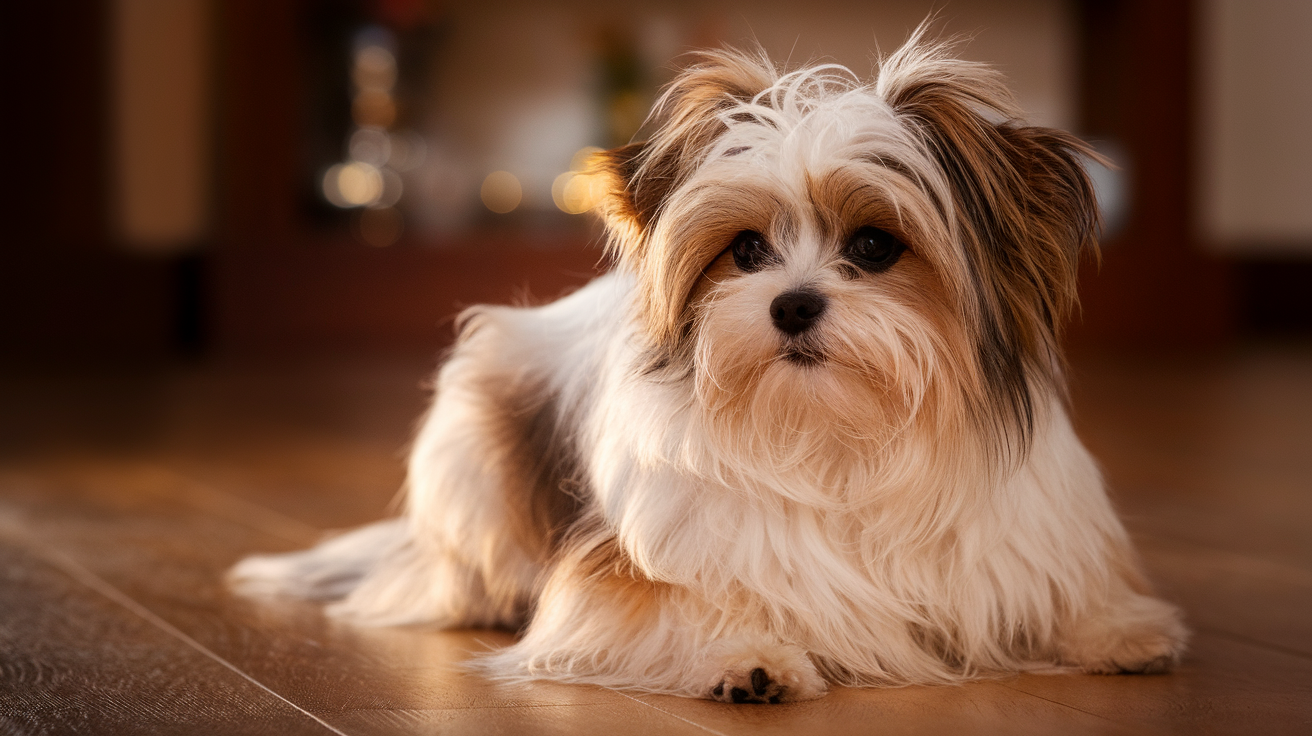Small dogs have captured the hearts of many pet lovers, especially those new to dog ownership. Their compact size and adorable appearance make them appealing companions for various living situations. However, not all small breeds are created equal when it comes to trainability and suitability for first-time owners.
Certain small dog breeds stand out for their intelligence, eagerness to please, and adaptability. These qualities make them easier to train and more suitable for novice dog owners. Breeds like the Bichon Frise, Cavalier King Charles Spaniel, and Miniature Schnauzer often excel in obedience training and quickly learn basic commands.
Training is crucial for small dogs, regardless of their breed. It helps establish good behavior, prevents common issues like excessive barking or nipping, and strengthens the bond between dog and owner. In the sections below, we’ll explore five small dog breeds that are particularly well-suited for first-time owners, discussing their traits and training potential.
- What are the top 5 small dog breeds for first-time owners?
- How does the Toy Poodle excel in training?
- Why are Papillons great for novice trainers?
- What makes Cavalier King Charles Spaniels easy to train?
- Why do Bichon Frises respond well to training?
- How do Miniature Schnauzers adapt to training?
- Unleashing the Potential of Small Dog Training
- Frequently Asked Questions
What are the top 5 small dog breeds for first-time owners?
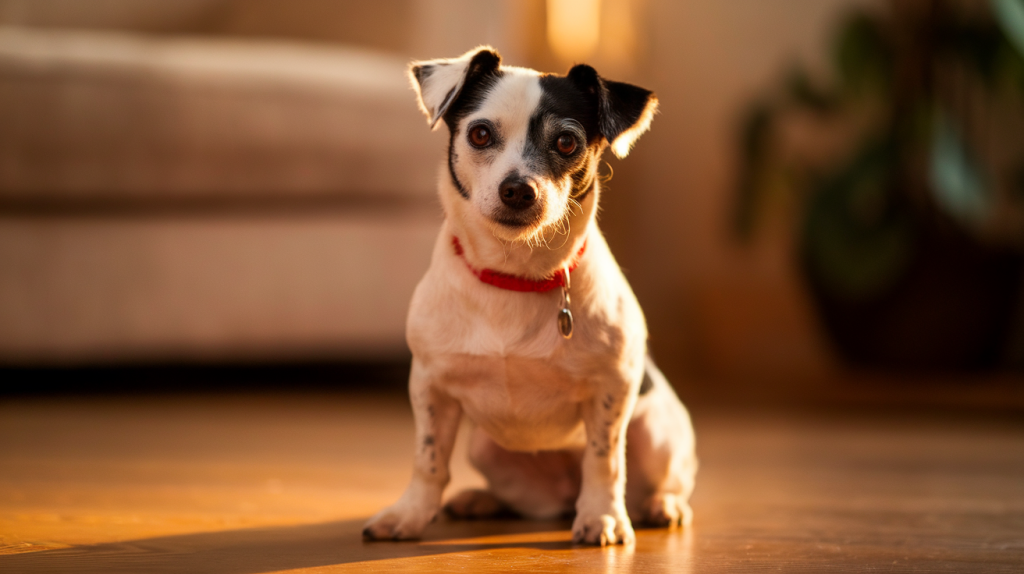
Choosing the perfect furry companion can be an exciting yet daunting task for first-time dog owners. Small breeds often make excellent choices due to their manageable size and adaptability to various living situations. But which ones are the best fit for novice pet parents? Let’s see five small dog breeds that are particularly well-suited for those new to dog ownership.
Poodle (Toy or Miniature)
Poodles are renowned for their intelligence and elegance. Whether you opt for the Toy or Miniature variety, these pups pack a lot of personality into a small package. Their hypoallergenic coat is a bonus for allergy sufferers, but it does require regular grooming to maintain its pristine appearance.
What makes Poodles ideal for first-time owners? Their eagerness to please and high trainability top the list. These clever canines excel in obedience training and can quickly pick up new commands. They’re also adaptable to different living environments, making them suitable for both apartment dwellers and those with spacious homes.
However, potential Poodle parents should be prepared for an energetic companion. These dogs thrive on mental and physical stimulation, so daily walks and interactive play sessions are a must. Puzzle toys can help keep their sharp minds engaged when you’re not actively training or playing with them.
Papillon
With their distinctive butterfly-like ears, Papillons are as charming as they are intelligent. These petite pups are known for their lively and friendly nature, making them wonderful companions for those new to dog ownership.
Papillons are quick learners and respond well to positive reinforcement training methods. Their small size doesn’t diminish their big personalities, and they often surprise first-time owners with their confidence and adaptability.
One of the great advantages of Papillons is their relatively low grooming needs compared to some other small breeds. While they do have a long, silky coat, it doesn’t tend to mat easily, making maintenance more manageable for novice dog owners.
These spirited little dogs also have a playful streak that can keep their owners entertained for hours. They enjoy interactive games and can be quite agile, often excelling in dog sports like agility or obedience competitions.
Cavalier King Charles Spaniel
For those seeking a gentle and affectionate companion, the Cavalier King Charles Spaniel is hard to beat. These sweet-natured dogs are known for their calm demeanor and adaptability, making them an excellent choice for first-time dog owners.
Cavaliers are typically easy to train due to their desire to please their owners. They respond well to gentle guidance and positive reinforcement, making the training process enjoyable for both dog and owner. Their moderate exercise needs are well-suited to a variety of lifestyles, from apartment living to homes with yards.
One of the most endearing qualities of Cavaliers is their affectionate nature. They thrive on human companionship and are often content to curl up on the couch with their owners. This makes them ideal for those who want a loving, low-key pet.
However, potential Cavalier owners should be aware of the breed’s grooming needs. Their silky coat requires regular brushing to prevent tangles and mats. Additionally, like many small breeds, they can be prone to certain health issues, so regular veterinary check-ups are important.
Bichon Frise
With their fluffy white coats and cheerful dispositions, Bichon Frises are like living stuffed animals. These playful pups are known for their friendly and affectionate nature, making them wonderful companions for first-time dog owners.
Bichons are generally easy to train and eager to please, which can make the transition to dog ownership smoother for novices. They’re also adaptable to various living situations, thriving in both apartments and houses with yards.
One of the standout features of the Bichon Frise is their hypoallergenic coat, which sheds minimally. This can be a significant advantage for allergy sufferers or those who prefer a cleaner home. However, their fluffy coats do require regular grooming to maintain their signature look.
Bichons are known for their playful and sometimes mischievous nature. They enjoy interactive games and can provide endless entertainment with their antics. This playfulness, combined with their affectionate nature, makes them excellent family dogs.
Here are some key traits that make Bichon Frises great for first-time owners:
- Friendly and sociable nature
- Adaptable to various living situations
- Minimal shedding
- Moderate exercise needs
- Eager to please and relatively easy to train
Miniature Schnauzer
Rounding out our list is the spunky and intelligent Miniature Schnauzer. These bearded beauties are known for their alert and spirited personalities, making them excellent watchdogs despite their small size.
Miniature Schnauzers are highly trainable and respond well to consistent, positive reinforcement. Their intelligence and eagerness to please can make training sessions enjoyable for both dog and owner. This breed also tends to be less vocal than some other small breeds, which can be a plus for those living in close quarters with neighbors.
One of the advantages of Miniature Schnauzers for first-time owners is their adaptability. They can thrive in various living situations and are generally good with children and other pets when properly socialized. Their moderate exercise needs can typically be met with daily walks and play sessions.
While Miniature Schnauzers do require regular grooming to maintain their distinctive beard and eyebrows, their coats are relatively low-shedding. This can be a significant benefit for those who want a cleaner home or have mild allergies.
These spirited little dogs also have a playful side that can keep their owners entertained. They enjoy interactive games and can be quite clever in figuring out puzzle toys, providing mental stimulation that can help prevent boredom-related behaviors.
Selecting the right small dog breed as a first-time owner is about finding a balance between your lifestyle and the dog’s needs. Each of these five breeds offers unique qualities that can make them excellent companions for novice dog owners. From the intelligent Poodle to the cheerful Bichon Frise, there’s a small breed out there to suit various preferences and living situations. The key is to research thoroughly, consider your lifestyle carefully, and be prepared for the commitment of dog ownership.
How does the Toy Poodle excel in training?
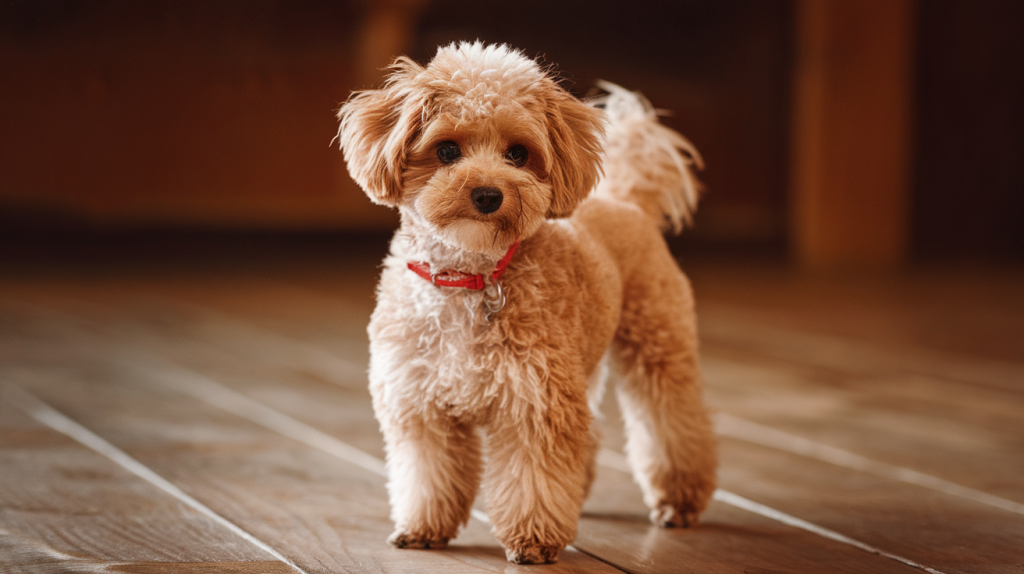
Toy Poodles are renowned for their exceptional training abilities, making them a favorite among dog enthusiasts and first-time owners alike. These pint-sized pooches pack a powerful punch when it comes to learning and adapting to various commands and situations. But what exactly makes them stand out in the training arena?
Let’s explore the fascinating world of Toy Poodle training and uncover the secrets behind their remarkable aptitude for learning. From their quick-witted nature to their eagerness to please, these diminutive dogs have a lot to offer in the training department.
Why are Toy Poodles considered highly intelligent?
Toy Poodles consistently rank among the brightest canine breeds, often placing second in intelligence tests. This impressive cognitive ability stems from their history as working dogs, originally bred for water retrieval. Their sharp minds allowed them to excel at complex tasks, a trait that has been carefully preserved through selective breeding.
But what does this intelligence look like in practice? Toy Poodles exhibit an uncanny ability to read human body language and anticipate commands. They’re quick to pick up on patterns and routines, often learning new behaviors through observation alone. This natural aptitude for learning extends beyond simple commands to more complex problem-solving tasks.
Interestingly, their small size may contribute to their quick-thinking nature. Some experts suggest that the compact brain of a Toy Poodle allows for faster neural connections, potentially enhancing their cognitive processing speed. While this theory requires further research, it’s clear that these tiny dogs possess an outsized intellect.
What training methods work best for Poodles?
Given their sharp minds and eager-to-please nature, Toy Poodles respond exceptionally well to positive reinforcement techniques. But what exactly does this entail? Let’s break it down:
- Clicker training: This method uses a distinct sound to mark desired behaviors, followed by a reward. Toy Poodles quickly associate the click with positive outcomes, making it an effective tool for shaping new behaviors.
- Reward-based training: Utilizing treats, praise, or playtime as incentives can motivate these clever canines to learn and perform commands with enthusiasm.
- Short, engaging sessions: Due to their high energy levels, Toy Poodles benefit from brief, focused training periods. Aim for 5-10 minute sessions several times a day to maintain their interest and prevent burnout.
- Mental stimulation games: Incorporating puzzle toys and interactive games into training can challenge their intellect while reinforcing desired behaviors.
Consistency is key when training a Toy Poodle. Establish clear rules and expectations from the start, and stick to them across all family members to avoid confusion.
How quickly can Toy Poodles learn new commands?
The learning speed of Toy Poodles often astounds their owners. On average, these clever canines can grasp a new command in less than five repetitions. Compare this to other breeds that might require 25-40 repetitions, and you’ll understand why Toy Poodles are considered training prodigies.
But does this mean they’ll master every command instantly? Not quite. While they may understand a command quickly, perfecting it still requires practice and reinforcement. Think of it like learning a new language – you might grasp the basics rapidly, but fluency takes time and consistent effort.
It’s worth noting that individual Toy Poodles may vary in their learning speed. Factors such as age, previous training experience, and individual personality can all influence how quickly a dog picks up new commands. Patience and persistence remain crucial, even with these quick learners.
What are some common challenges in training Toy Poodles?
Despite their intelligence, Toy Poodles aren’t without their training hurdles. One significant challenge is their sensitivity. These dogs are highly attuned to their owner’s emotions and can become easily discouraged by harsh corrections or raised voices. A gentle, patient approach yields the best results.
Another potential obstacle is their tendency towards stubbornness. Toy Poodles are known for their independent streak, which can sometimes manifest as selective hearing or a reluctance to comply with commands. How can you overcome this? By making training sessions engaging and rewarding, you’ll tap into their desire to please and their love of mental stimulation.
Socialization presents another crucial area for focus. Without proper exposure to various people, animals, and environments, Toy Poodles can develop anxiety or fear-based behaviors. Early and consistent socialization helps prevent these issues and creates a well-rounded, confident dog.
Lastly, their high energy levels can sometimes interfere with focused training. Regular exercise and playtime are essential to help burn off excess energy before settling into a training session.
How do Toy Poodles respond to positive reinforcement?
Positive reinforcement is the cornerstone of effective Toy Poodle training, and these intelligent dogs respond to it with enthusiasm. Their eagerness to please, combined with their quick learning ability, makes them ideal candidates for reward-based training methods.
When praised and rewarded for desired behaviors, Toy Poodles often display increased confidence and a willingness to try new things. This positive approach fosters a strong bond between dog and owner, creating a partnership based on trust and mutual understanding.
But what forms of positive reinforcement work best? While treats are often a go-to reward, Toy Poodles also respond well to verbal praise, physical affection, and playtime. Varying the rewards keeps training sessions exciting and unpredictable, further engaging their clever minds.
It’s important to note that timing is crucial when using positive reinforcement. Rewards should be given immediately after the desired behavior to create a clear association. With consistent, well-timed rewards, Toy Poodles quickly learn to repeat behaviors that earn them praise and treats.
In the world of dog training, Toy Poodles stand out as exceptional students. Their combination of intelligence, eagerness to please, and responsiveness to positive reinforcement makes them a joy to train. Whether you’re teaching basic obedience or complex tricks, these pint-sized pooches are always ready to rise to the challenge.
Why are Papillons great for novice trainers?
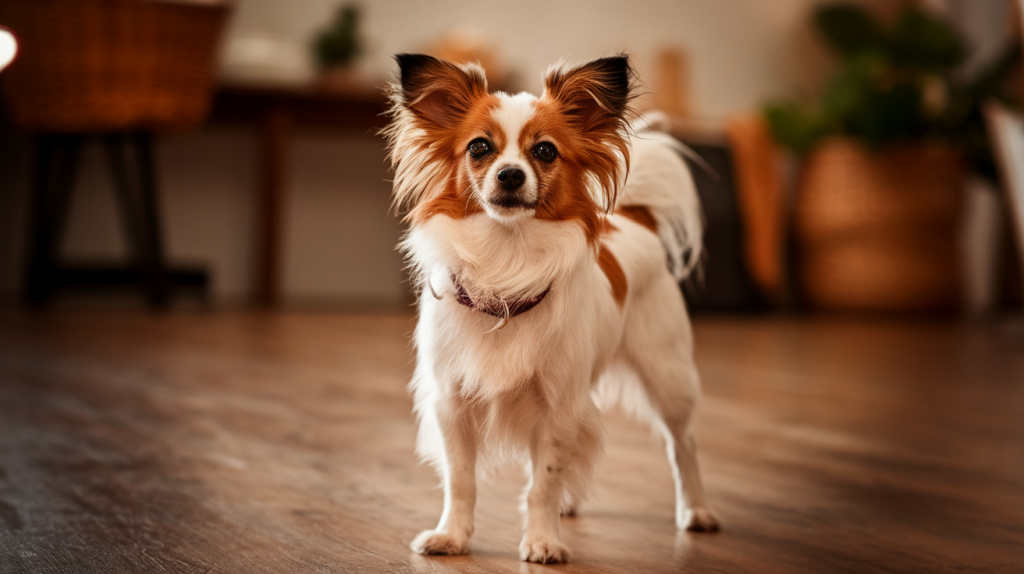
Papillons, with their butterfly-like ears and sparkling personalities, have become increasingly popular among dog enthusiasts. But what makes these pint-sized pooches particularly appealing to novice trainers? Let’s explore the charming qualities that set Papillons apart in the training arena.
Imagine a tiny dog with the intelligence of a scholar and the enthusiasm of a cheerleader. That’s your Papillon in a nutshell. These little dynamos bring a unique blend of smarts and spirit to the training table, making them ideal companions for those new to dog training.
But why exactly do Papillons excel in the hands of novice trainers? The answer lies in their innate characteristics and the way they approach learning. Let’s break it down:
What makes Papillons eager to learn?
At the heart of a Papillon’s trainability is their insatiable curiosity. These dogs view the world as one big playground, full of exciting discoveries waiting to be made. This natural inquisitiveness translates into an eagerness to learn that can make training sessions feel more like playtime than work.
Papillons also possess a strong desire to please their human companions. This trait, combined with their sharp minds, creates a perfect storm of trainability. They’re not just following commands; they’re actively trying to figure out what you want from them.
Think of your Papillon as a furry little problem-solver. They thrive on mental stimulation and view training challenges as puzzles to be cracked. This attitude can make the training process enjoyable for both dog and owner.
How do Papillons perform in obedience training?
When it comes to obedience training, Papillons often shine brighter than their diminutive size might suggest. Their quick wit and keen observation skills allow them to pick up commands rapidly, often mastering basic obedience cues in record time.
But it’s not just about speed. Papillons bring a level of precision to their obedience work that can rival much larger breeds. Their small size and agility enable them to execute commands with a grace and accuracy that’s truly impressive to watch.
One of the key advantages Papillons offer in obedience training is their focus. Despite their energetic nature, these little dogs can concentrate intensely when properly motivated. This ability to zero in on the task at hand makes them highly responsive to training cues.
What are some fun tricks Papillons can easily master?
Papillons aren’t just about basic obedience; they excel at learning tricks that can impress and entertain. Their agility and intelligence make them naturals at a wide range of fun and challenging tricks. Here are some examples:
- “Spin” and “Twirl”: Papillons can learn to turn in circles on command, showcasing their nimble nature.
- “High Five”: Their dexterous paws make this crowd-pleasing trick a breeze for Papillons to learn.
- “Play Dead”: With their flair for the dramatic, Papillons often enjoy hamming it up with this classic trick.
- “Fetch”: Despite their small size, many Papillons love a good game of fetch and can learn to retrieve objects on command.
- “Weave”: Teaching your Papillon to weave between your legs as you walk can be a fun and impressive trick to show off.
How to keep Papillons motivated during training sessions?
Maintaining a Papillon’s interest during training is key to success. These little dogs have big personalities and can become bored quickly if training becomes repetitive. The secret? Variety and positive reinforcement.
Mix up your training routines regularly. Papillons thrive on novelty, so introducing new challenges or alternating between different commands can keep them engaged. Short, frequent training sessions often work better than long, drawn-out ones.
Rewards play a crucial role in motivating Papillons. While they respond well to treats, many also work enthusiastically for praise or play. Experiment with different rewards to find what gets your Papillon’s tail wagging the most.
Papillons are sensitive souls. Harsh corrections can dampen their spirits and enthusiasm for learning. Always opt for positive reinforcement techniques, celebrating their successes and gently guiding them through mistakes.
What role does early socialization play in Papillon training?
Early socialization is the secret ingredient that can transform a good Papillon into a great one. Exposing your Papillon puppy to a wide range of people, animals, and environments during their formative weeks can set the stage for a well-adjusted adult dog.
Socialization helps build confidence, which is crucial for effective training. A well-socialized Papillon is more likely to approach new training scenarios with curiosity rather than fear, making the learning process smoother and more enjoyable for everyone involved.
Moreover, early socialization can help prevent behavioral issues that might interfere with training later on. Papillons who are comfortable in various situations are less likely to develop anxiety or aggression, allowing their natural eagerness to learn to shine through.
In the grand tapestry of dog training, Papillons weave a unique and colorful thread. Their combination of intelligence, eagerness to please, and adaptability makes them a joy for novice trainers to work with. Whether you’re teaching basic obedience or advanced tricks, these little butterflies of the dog world are ready to spread their wings and soar in the training ring.
What makes Cavalier King Charles Spaniels easy to train?
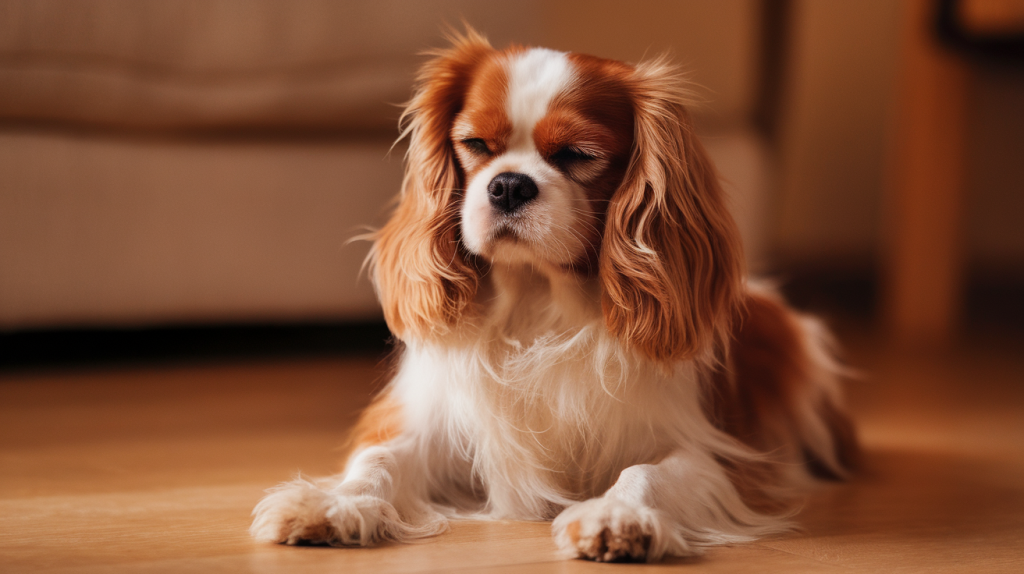
Cavalier King Charles Spaniels have a reputation for being delightful companions, but did you know they’re also a breeze to train? These charming pups combine intelligence with an eagerness to please, making them ideal candidates for various training exercises.
How does the Cavalier’s gentle nature affect trainability?
The Cavalier’s gentle disposition is more than just a cute trait – it’s a powerful tool in the training toolbox. These dogs are naturally calm and patient, which means they’re less likely to get frustrated or distracted during training sessions. Their easygoing nature allows them to focus on you and the task at hand, rather than becoming overwhelmed by their surroundings.
But don’t mistake their gentleness for a lack of enthusiasm! Cavaliers are known for their joyful approach to life, and this extends to their training. They’re often eager to engage in new activities and learn new skills, especially when it means spending time with their favorite humans.
What are effective training techniques for Cavaliers?
Now that we understand how a Cavalier’s nature plays into their trainability, let’s talk about some effective techniques to use with these lovable pups. Positive reinforcement is the name of the game here. Cavaliers respond exceptionally well to praise, treats, and affection as rewards for good behavior.
One particularly effective method is clicker training. The distinct sound of a clicker can help your Cavalier associate the exact moment of desired behavior with a reward, making it easier for them to understand what you’re asking of them.
Short, frequent training sessions often yield the best results. Aim for 5-10 minute sessions several times a day rather than one long session. This keeps your Cavalier engaged and prevents boredom or fatigue from setting in.
Here are some key points to remember when training your Cavalier:
- Use a cheerful, upbeat tone of voice
- Be consistent with your commands and expectations
- Incorporate plenty of play and cuddle time into your training routine
- Always end on a positive note, even if progress seems slow
How to use the Cavalier’s affectionate nature in training?
The Cavalier’s loving personality isn’t just adorable – it’s a powerful motivator in training. These dogs thrive on human interaction and approval, which means your attention and affection can be just as rewarding as treats.
Try using praise and petting as rewards during training sessions. You might be surprised at how effective a simple “Good dog!” and a gentle pat can be. This approach not only reinforces good behavior but also strengthens the bond between you and your furry friend.
Another way to harness your Cavalier’s affectionate nature is through play-based training. Incorporate games like fetch or tug-of-war into your training routine. This not only makes learning more fun for your dog but also taps into their natural desire to please you and spend time with you.
What are some common training goals for Cavaliers?
While every dog is unique, there are some training goals that are particularly well-suited to Cavaliers. Basic obedience commands like “sit,” “stay,” and “come” are essential and usually easy for these intelligent dogs to master.
Leash training is another important goal, as Cavaliers love to explore the world around them. Teaching them to walk calmly on a leash will make your daily walks more enjoyable for both of you.
Socialization is crucial for Cavaliers. These friendly dogs generally love meeting new people and animals, but proper socialization helps ensure they remain confident and well-behaved in various situations.
Finally, many Cavalier owners find success in training their dogs for therapy work. Their gentle nature and love of people make them excellent candidates for bringing comfort to those in hospitals, nursing homes, or schools.
How to address potential stubbornness in Cavaliers?
While Cavaliers are generally eager to please, like all dogs, they can have their stubborn moments. The key to overcoming this is patience and creativity in your training approach.
If you find your Cavalier is resisting a particular command or behavior, try breaking it down into smaller, more manageable steps. Celebrate each tiny victory along the way to keep your pup motivated.
Mixing up your training routine can also help combat stubbornness. If your usual methods aren’t working, try incorporating new games or challenges that appeal to your Cavalier’s playful nature.
Why do Bichon Frises respond well to training?
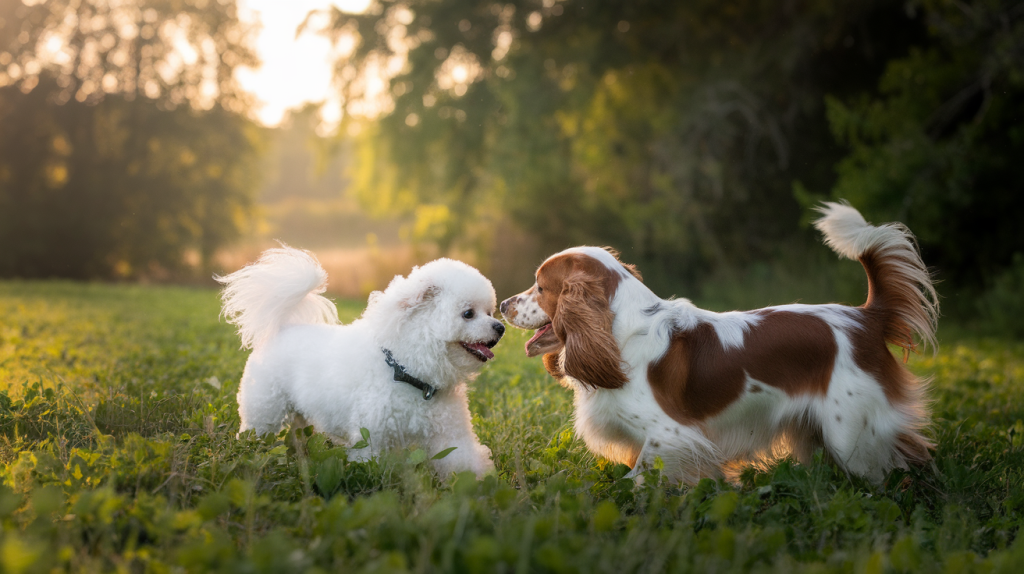
Bichon Frises are often celebrated for their cheerful disposition and intelligence, but what makes them particularly responsive to training? These small, fluffy companions bring a unique blend of traits that make teaching them both enjoyable and rewarding.
What training methods are most effective for Bichon Frises?
Bichons thrive on positive reinforcement, making reward-based training the most effective approach. This method involves rewarding desired behaviors with treats, praise, or playtime, encouraging your dog to repeat those actions. Their eagerness to please makes this technique particularly successful.
Clicker training is another method that works well with Bichons. The distinct sound of a clicker helps mark the exact moment your dog performs the desired behavior, followed by a reward. This clear communication helps your Bichon quickly understand what you’re asking of them.
Short, frequent training sessions are ideal for this breed. Aim for 5-10 minutes per session to keep their attention and enthusiasm high. Consistency in commands and rewards is key to helping your Bichon grasp new skills effectively.
How to use the Bichon’s playful nature in training sessions?
Bichons are naturally playful dogs, and incorporating fun into training can make the process more engaging for both of you. These dogs love games, so turning commands into playful activities can keep them motivated.
For example, you can teach them commands like “fetch” or “roll over” during playtime. Use their favorite toys as rewards or incorporate them into the training itself. A game of tug-of-war can be a great way to practice commands like “drop it” or “take it.”
Below are some playful ways to integrate training into daily activities:
- Use hide-and-seek games to teach recall commands like “come.”
- Incorporate agility exercises like weaving through obstacles while practicing “stay.”
- Play fetch as a way to reinforce “drop it” or “bring it.”
- Use puzzle toys during breaks to stimulate their minds.
- Reward successful commands with a quick play session.
By blending play with learning, you’ll keep your Bichon engaged and excited about training.
What are some challenges in training Bichon Frises?
While Bichons are intelligent and eager to please, they aren’t without their quirks. One common challenge is their occasional stubbornness. These dogs may test boundaries or lose interest if they don’t see an immediate benefit in following commands.
Another challenge is housebreaking. Due to their small size and sensitive nature, Bichons can be difficult to potty train. Accidents may occur if they’re not given consistent opportunities to go outside or if they feel stressed.
Distractions can also pose a problem during training sessions. Their curious nature means they may become easily sidetracked by new sights or sounds. To address this, start training in a quiet environment before gradually introducing distractions.
Patience is essential when working through these challenges. Stay calm and consistent, and avoid harsh corrections that could discourage your dog.
How to maintain consistency in Bichon Frise training?
Consistency is the cornerstone of successful training for any dog, but it’s especially important for Bichons. These dogs thrive on routine and clear expectations, so maintaining a structured approach will help them learn faster.
Use the same command words for each behavior you’re teaching. For instance, if you’re teaching “sit,” avoid switching between “sit down” and “sit.” This consistency helps your dog associate specific words with specific actions.
Establish a regular schedule for training sessions. Whether it’s morning walks or evening playtime, sticking to a routine helps reinforce good habits. Consistency also applies to everyone in your household—make sure all family members use the same commands and rewards system.
If you’re working on housebreaking or other behavior-specific goals, set up a predictable routine for bathroom breaks or feeding times. This structure helps your dog understand what’s expected of them.
What role does positive reinforcement play in training Bichons?
Positive reinforcement is at the heart of effective Bichon Frise training. These dogs respond best when they’re rewarded for good behavior rather than punished for mistakes. This approach builds trust and strengthens the bond between you and your furry friend.
Treats are often used as rewards during positive reinforcement training, but variety can keep things interesting. Verbal praise, petting, or even extra playtime can be just as motivating for your dog.
Timing is crucial when using positive reinforcement. Rewards should be given immediately after the desired behavior so your dog can make the connection between their action and the reward. For example, if your Bichon sits on command, offer praise or a treat within seconds of them sitting.
As your dog becomes more consistent with certain behaviors, you can gradually reduce the frequency of treats while continuing to offer praise or affection. This helps ensure that good behavior becomes a habit rather than something they do only when treats are involved.
Bichon Frises bring enthusiasm and charm to every aspect of life, including training sessions. By understanding their playful nature and using positive reinforcement techniques, you’ll create an enjoyable learning experience that benefits both you and your furry companion.
How do Miniature Schnauzers adapt to training?
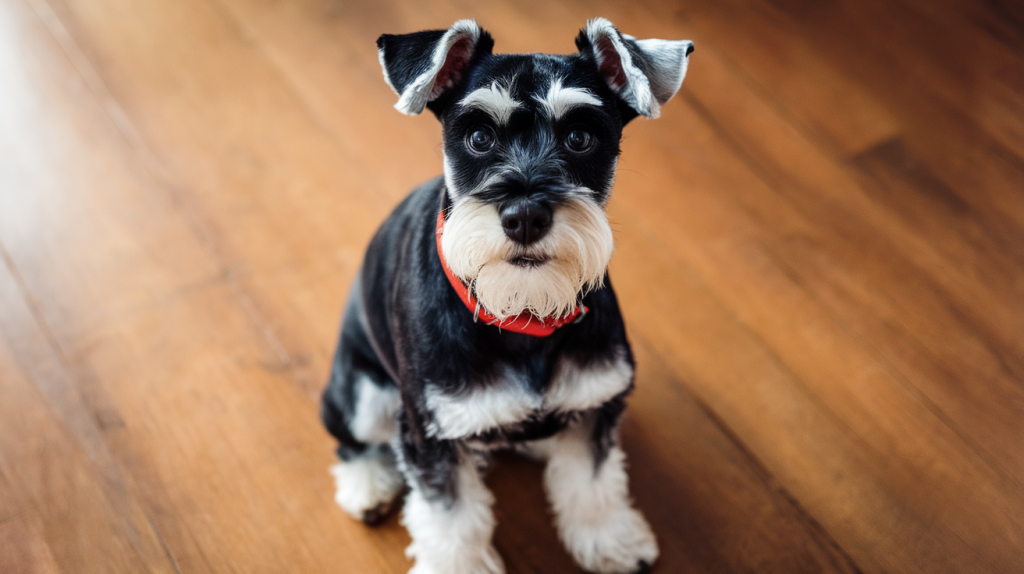
Miniature Schnauzers are known for their spirited personalities and intelligence, making them a breed that often excels in training. Their adaptability and eagerness to please set them apart as attentive learners. Understanding how these traits influence their training can help you create a positive and effective learning environment for your furry friend.
What makes Miniature Schnauzers attentive learners?
The intelligence of Miniature Schnauzers is one of their standout characteristics. This breed is naturally curious and enjoys engaging with their environment, which makes them quick learners. Their ability to understand commands and cues is impressive, often leading to rapid mastery of new skills.
Additionally, Miniature Schnauzers have a strong desire to please their owners. This eagerness means they are often motivated to follow commands and complete tasks, especially when they know there’s a reward involved. Their playful nature also contributes to their attentiveness during training sessions.
Here are some key traits that make them effective learners:
- High intelligence
- Strong desire to please
- Playful and energetic disposition
- Ability to adapt to various training methods
How to channel a Miniature Schnauzer’s energy into training?
Miniature Schnauzers are lively dogs with plenty of energy, which can be harnessed during training sessions. Engaging their minds and bodies is essential for effective learning. Incorporating physical activity into training can help keep them focused and prevent boredom.
Consider using games that require movement, such as fetch or agility exercises. These activities not only provide physical exercise but also stimulate their minds, making them more receptive to learning commands.
Here are some ideas for channeling their energy:
- Incorporate fetch into training sessions to reinforce commands like “come” or “drop it.”
- Set up an agility course in your backyard using household items.
- Use interactive toys that challenge their problem-solving skills.
- Schedule regular play sessions to burn off excess energy before training.
What are some breed-specific training tips for Miniature Schnauzers?
Training a Miniature Schnauzer can be straightforward when you consider their unique characteristics. Here are some specific tips that cater to their needs:
- Start Early: Begin training as soon as you bring your puppy home. Early exposure helps establish good habits.
- Use Positive Reinforcement: Rewarding good behavior with treats or praise encourages them to repeat those actions.
- Keep Sessions Short: Due to their relatively short attention spans, limit training sessions to 10-15 minutes.
- Be Consistent: Use the same commands and signals consistently so your dog understands what you expect.
- Engage Their Minds: Incorporate mental challenges in addition to physical exercises to keep them stimulated.
How to address potential barking issues through training?
Miniature Schnauzers are known for being vocal, which can sometimes lead to excessive barking. Addressing this behavior early on is crucial for maintaining harmony in your home.
Start by identifying the triggers that cause your Schnauzer to bark. Common triggers include doorbells, other dogs, or unfamiliar noises. Once you’ve identified these stimuli, you can work on desensitizing your dog through gradual exposure while rewarding calm behavior.
Here are some strategies for managing barking:
- Teach the “quiet” command by rewarding silence after barking.
- Redirect their attention with toys or treats when they start barking.
- Provide plenty of mental stimulation through puzzle toys or interactive games.
- Ensure they receive adequate exercise to reduce pent-up energy that may lead to barking.
What advanced training can Miniature Schnauzers excel in?
Once your Miniature Schnauzer has mastered basic commands, they can thrive in advanced training scenarios. Their intelligence and eagerness make them excellent candidates for various dog sports and tricks.
Consider enrolling your dog in agility classes or obedience competitions where they can showcase their skills. Advanced tricks such as “roll over,” “play dead,” or even more complex tasks like scent work can keep them engaged and mentally stimulated.
Here are some advanced training ideas:
- Agility Training: Set up an obstacle course for them to navigate.
- Trick Training: Teach fun tricks that impress family and friends.
- Scent Work: Use their keen sense of smell in games where they find hidden treats.
- Obedience Competitions: Participate in events that challenge their skills while providing socialization opportunities.
Miniature Schnauzers adapt remarkably well to training due to their intelligence, eagerness, and playful nature. By understanding how these traits influence their learning process, you can create a structured and engaging environment that fosters positive behaviors and strengthens the bond between you and your furry companion.
Unleashing the Potential of Small Dog Training
Training small dogs can be a rewarding experience for first-time owners, especially women seeking a loyal and intelligent companion. From the quick-witted Toy Poodle to the spirited Miniature Schnauzer, each breed brings its own unique qualities to the training process. By understanding these traits and adapting your approach accordingly, you can create a strong bond with your furry friend while developing their skills and behaviors.
Whether you’re drawn to the gentle nature of the Cavalier King Charles Spaniel or the playful energy of the Bichon Frise, remember that patience, consistency, and positive reinforcement are key to successful training. As you embark on this journey with your small canine companion, you’ll discover that the process of teaching and learning together can be just as enjoyable as the end result. With dedication and the right techniques, you’ll soon have a well-behaved, happy pup that fits perfectly into your lifestyle.
Frequently Asked Questions
Q: Which small dog breed is considered the most intelligent?
A: The Toy Poodle is often regarded as one of the most intelligent small dog breeds, known for their quick learning abilities and adaptability.
Q: How long should training sessions be for small dogs?
A: Training sessions for small dogs should typically be short, around 5-10 minutes, to maintain their focus and enthusiasm.
Q: Are Cavalier King Charles Spaniels easy to train?
A: Yes, Cavalier King Charles Spaniels are generally easy to train due to their gentle nature and eagerness to please their owners.
Q: What’s the best way to motivate a Bichon Frise during training?
A: Bichon Frises respond well to positive reinforcement, including treats, praise, and playtime as rewards for good behavior.
Q: How can I address excessive barking in Miniature Schnauzers?
A: To address barking in Miniature Schnauzers, identify triggers, teach the “quiet” command, and provide mental stimulation through puzzle toys and interactive games.
Q: Are Papillons good for first-time dog owners?
A: Yes, Papillons are excellent for first-time owners due to their intelligence, adaptability, and eagerness to learn.
Q: What type of advanced training can small dogs excel in?
A: Small dogs can excel in various advanced training activities, including agility courses, trick training, scent work, and obedience competitions.
Q: How important is early socialization for small dog breeds?
A: Early socialization is crucial for small dog breeds to help them develop confidence and prevent behavioral issues later in life.

